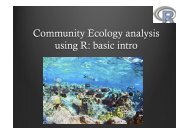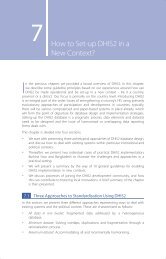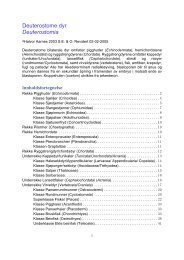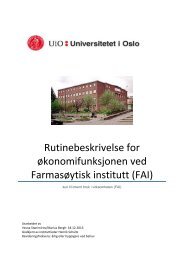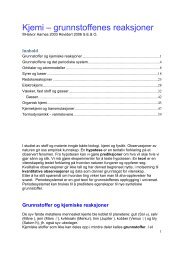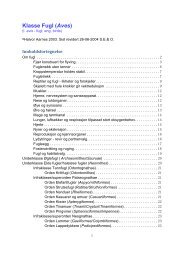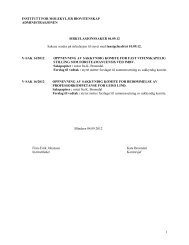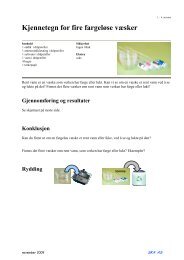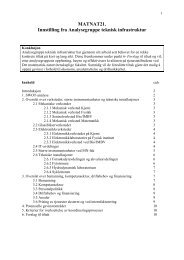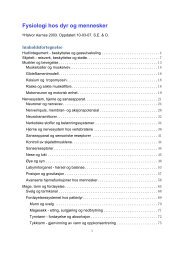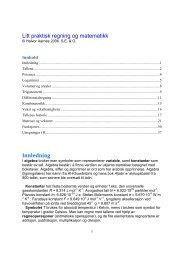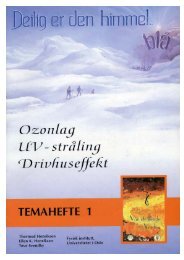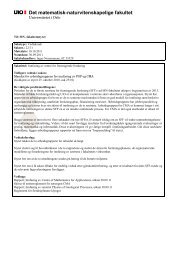MERG - Universitetet i Oslo
MERG - Universitetet i Oslo
MERG - Universitetet i Oslo
Create successful ePaper yourself
Turn your PDF publications into a flip-book with our unique Google optimized e-Paper software.
<strong>MERG</strong><br />
Phylogenomic and single cell whole genome amplification of<br />
Radiolaria<br />
Objectives of the project<br />
• Develop and optimize genome-sequencing methods for unculturable unicellular protists.<br />
• Partially sequence the genome and cDNA sequences from three radiolarian species in order to<br />
provide suitable data for: Investigation of the phylogenetic placement of Radiolaria by using<br />
multigene data (phylogenomics), and, Identification of sequence markers appropriate for<br />
species phylogeny and detection of cryptic species diversity.<br />
• Study the species phylogeny and cryptic diversity of radiolarian lineages by the use of a<br />
phylogenetic species concept and compare the molecular phylogeny with the current<br />
morphology-based systematics of the group.<br />
• Investigate symbionts and parasites associated with the radiolarian cells by using the developed<br />
molecular methods<br />
Callimitra carolotae, Lamprocyclas maritalis, mitrocalpis_araneafera, nephrospyris_knutheieri, Lamprocyclas maritalis. Photo: Kjell Bjørklund<br />
Project summary<br />
A major goal of the project is to develop methods for genomic investigations of unculturable unicellular<br />
eukaryotes, which comprise the vast majority of the species. A method known as single cell whole<br />
genome amplification (SCWGA) can provide enough DNA template for multiple downstream analyses.<br />
The method has not been widely applied on protists and there is therefore a great need for optimization<br />
and development. SCWGA will be coupled with the latest upgrade of the 454-pyrosequencing<br />
technology. Using these techniques we will study a group of unicellular eukaryotes (protists),<br />
Radiolaria, which like most other microorganisms, are notoriously difficult to grow in culture and are<br />
therefore virtually nothing is known about their genomes, ecology and species diversity. Hence this<br />
project will generate knowledge about both advanced molecular methods, applicable for any type of<br />
microorganism, and fundamental knowledge about a very much enigmatic lineage of eukaryotes. The<br />
coupling of SCWGA and 454-pyrosequencing will allow: - Investigation of the gene and genome<br />
organization of at least partial genomes of radiolarians. - Reconstruction of the genome evolution of<br />
members of the eukaryotic supergroup SAR (includes Radiolaria) as several species in SAR have been,<br />
or currently are being, genome sequenced. - Rigorous phylogenetic investigation of Radiolaria using a<br />
multigene approach (phylogenomics). - Identification of proper markers for population genetics and<br />
across-species studies. - Identification and characterization of associated symbionts or parasites.<br />
The team<br />
Jon Bråte (PhD), Anders Krabberød (PhD), Jane Dolven, Tom Kristensen, Randi Ose, Kjell Bjørklund,<br />
Dag Klaveness, Kamran Shalchian-Tabrizi<br />
19




